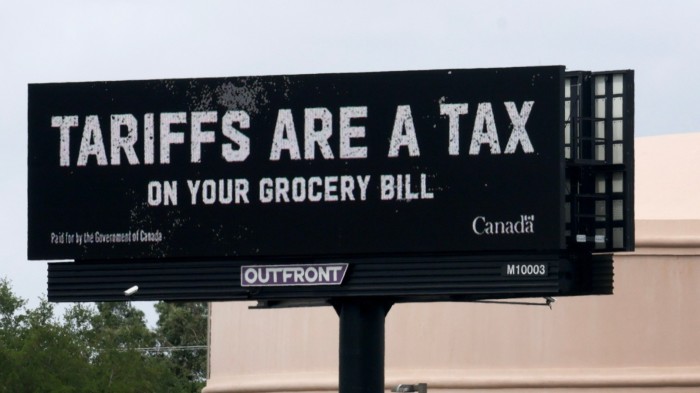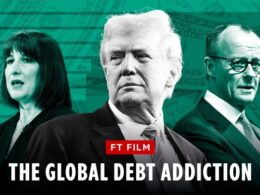Over the past week, numerous news organisations reported that Donald Trump has not yet decided on his trade policy. So, on the eve of tariff day — the day when US citizens will be subjugated to self-imposed trade barriers — I cannot explain the new tariff landscape, but I can examine the effects of the US president’s policies so far.
I am not going to exaggerate or take a deliberately contrarian view and I am fully aware that when the UK voted for Brexit, early economic signals were false friends. But it is hard to avoid the distinct stagflationary whiff coming out of the US. It is faint, but unpleasant. It was not there before the US election in November and has grown stronger since Trump’s inauguration in January.
If the trends continue, Federal Reserve chair Jay Powell will not be able to say the US economy is “strong” for much longer.
Soft data
The first place to look are the surveys of economic activity and inflation, which have often proved useful leading indicators. Starting with consumer confidence, the two long-running sources are compiled by the University of Michigan and the Conference Board think-tank. As shown in the chart below, which normalises the two measures so they can be included in one diagram, both have slumped since January.
The Michigan survey is distorted by highly partisan biases, and the divergence of the two indicators since the 2021-22 inflation is notable, so the trends need to be treated with some caution. But an increase in pessimism is evident. The question is whether these surveys will translate into spending caution among consumers. On this, Powell is sceptical, repeating that “the relationship between survey data and actual economic activity hasn’t been very tight”.
It is not just consumer confidence surveys that show a decline in economic sentiment. The Fed’s Beige Book in March recorded weaker activity than in January and stronger price pressures across much of the US. The Dallas Fed energy survey showed greater pessimism in the oil business, with executives saying that the administration’s chaotic policy process dimmed the outlook.
The inflationary part of stagflation is evident also in the University of Michigan consumer survey and in the New York Fed one-year ahead survey, but not its five-year ahead figures.
Hard data
Hard data arrives with a delay but is much more accurate. So far, the best evidence came last Friday from personal consumption expenditure data for February.
Expenditure ticked up since a fall in January, while incomes grew strongly and markets were spooked. But let’s not go over the top. There have been similar dips in expenditure before, as is clear from the chart below. The latest indication of consumer caution might be the start of something new, or just another wiggle in a line that is often volatile around a clear upward trend.
If the expenditure data is inconclusive, the inflation data is showing definitive signs of stickiness above the Fed’s 2 per cent target. While there might be some seasonal adjustment problems distorting the three-month and six-month rates, they are nevertheless rising. So is the FT core measure, which aggregates other underlying measures of inflationary pressure in a statistically optimal way.
As Powell said last month: “Inflation has started to move up now, we think partly in response to tariffs and there may be a delay in further progress over the course of this year.”
One article of faith for the Trump administration is that those outside the US pay the costs of tariffs by reducing prices of goods as they land in the country. Even though that belief runs counter to most of the evidence from 2018, officials such as Peter Navarro, White House senior counsellor for manufacturing and trade, keep repeating it (5:40 from an interview on Sunday).
Being a stuck record on a topic does not mean you are right, however. That data is far from reassuring from a US administration perspective. A 10 per cent tariff increase on Chinese goods went into effect on February 4. Recent official figures show import prices from China before tariffs are applied rose 0.5 per cent in February alone, half of their whole rise since December 2023.
If anything, the early evidence is that Chinese suppliers are using tariffs as an opportunity to disguise their own price increases in the spirit of Isabella Weber’s “sellers’ inflation” idea. That is not a good sign for the US. The tariffs might get absorbed in the American supply chain, but there is no evidence so far that any other country pays.
Market data
Information can also be derived from financial markets on output and inflation. Stock market declines this year suggest there are emerging concerns about output, while financial market data on inflation expectations are mixed. These have risen for the coming five and 20 years. But there has been little movement in expectations for the five years between 2030 and 2035. It is fair to say the movements, in the chart below, are not huge, although they are upwards.
The Fed’s response
As highlighted in the FT Monetary Policy Radar collection of Fed officials’ comments, Federal Open Market Committee members have become much less sanguine about inflation.
Austan Goolsbee, president of the Chicago Fed, said the trends so far had not been 1970s-style stagflation, but it is a time to “wait and see” on rates.
Mary Daly, president of the San Francisco Fed, said the lack of progress on inflation made her uncomfortable about “starting any kind of rate path declines right now”.
Thomas Barkin of the Richmond Fed worried that the anchor on inflationary expectations was looser than it was, as did Alberto Musalem, president of the St Louis Fed. Susan Collins at the Boston Fed worried that tariffs might have more of an inflationary impact than she previously thought, while Raphael Bostic of the Atlanta Fed said inflation was going to be “bumpy and not move dramatically and in a clear way to the 2 per cent target”.
That whiff of stagflation is real.
What I’ve been reading and watching
-
On Friday, the Washington DC Court of Appeals allowed the sacking of National Labor Relation’s Board member Gwynne Wilcox to stand on a two-to-one decision. The judgment airs the arguments on both sides that will ultimately go to the Supreme Court. Remember, if Wilcox loses, the Fed’s board is unlikely to be protected any longer against summary dismissal
-
It seems as though Trump’s response to auto executives’ warnings about price rises was to threaten price controls. Even economist Arthur Laffer is worried
-
Writing in the FT, Italy’s central bank governor Fabio Panetta warns that estimates of neutral interest rates are only helpful when policy is far from this level. Given the uncertainties, he calls for an end at the European Central Bank to using words such as “restrictive” when officials really have no idea
-
Hopefully, this video with Stephen Miran, chair of the US Council of Economic Advisers, is the end of talk of a Mar-a-Lago Accord. The interview is also notable for asserting that exporters to the US have “no alternative” to selling in America in another example of the administration’s hubris
A chart that matters
Delivering a fascinating Mais Lecture last week, ECB executive board member Isabel Schnabel examined the importance of financial literacy for decision-making for both people and central bankers. There is little doubt that those who understand basic financial concepts make better decisions, she said. This provides the rationale for the FT’s financial inclusion and literacy campaign, currently being evaluated by King’s College London.
Schnabel went further and showed with a series of charts that — to the extent that financial literacy matters more than just income or education with which it is correlated — households perceptions of inflation linger more among those with low financial literacy.
Monetary policy is therefore more effective if people are better informed.
Source link














